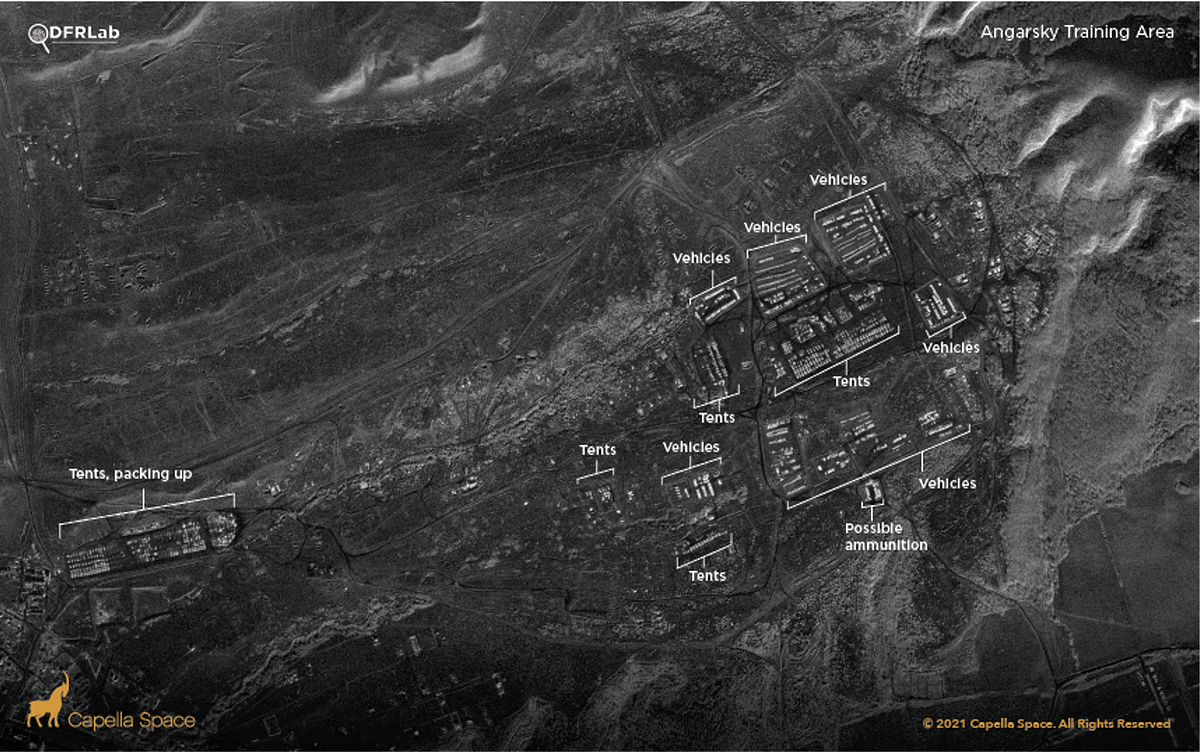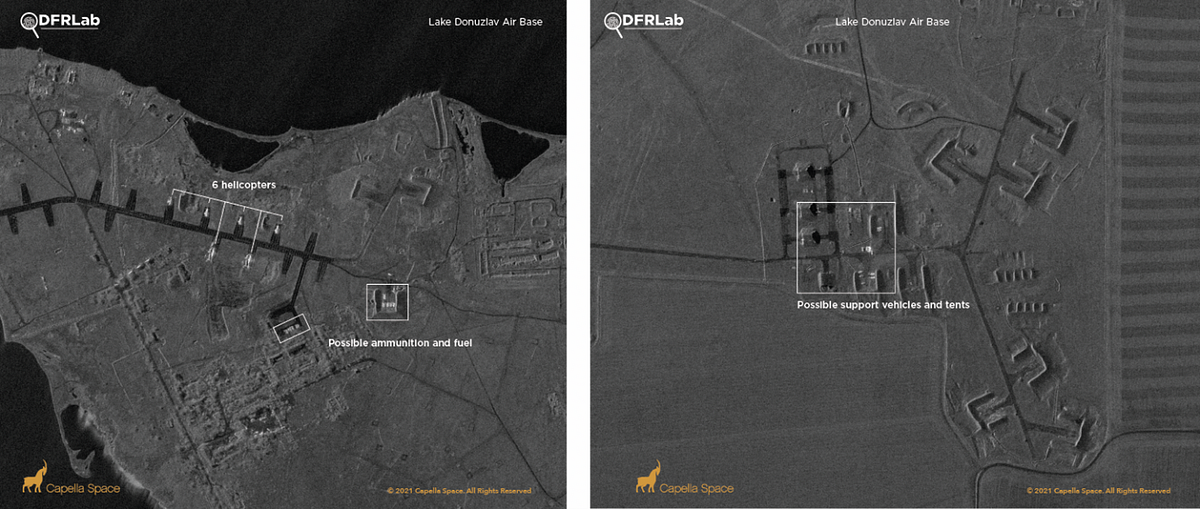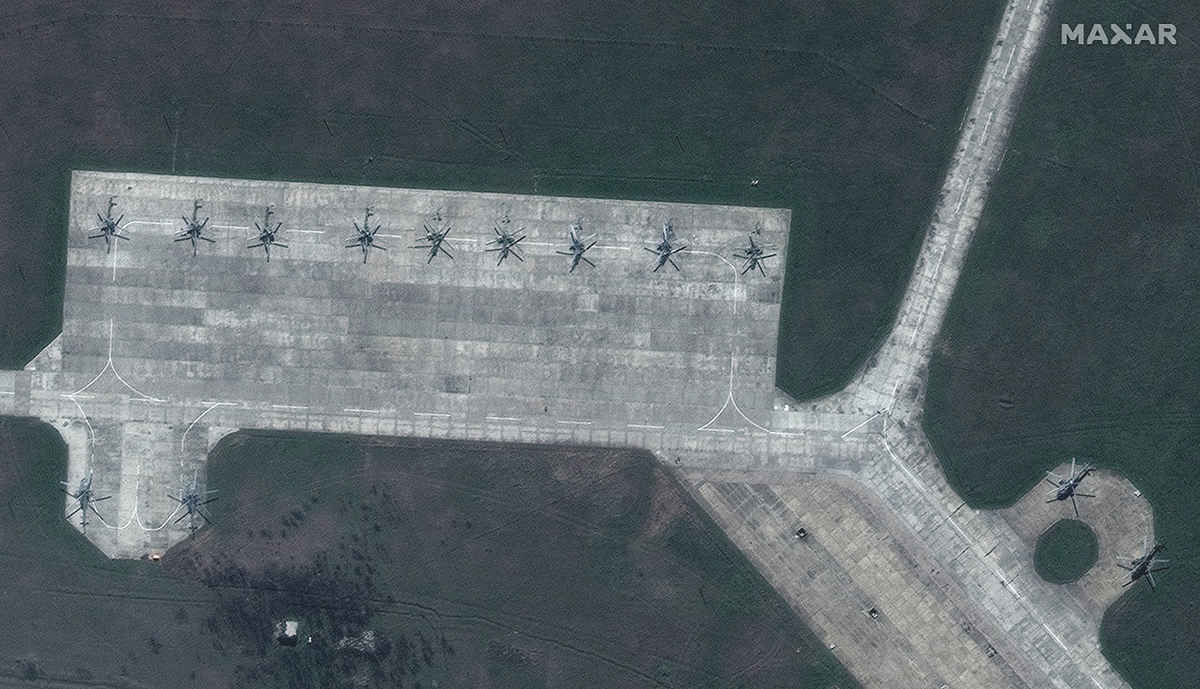Satellite imagery examined by the DFRLab shows troops and equipment amassed at Angarsky and Opuk prior to withdrawal announcement

By Michael Sheldon
From February through April 2021, Russia amassed troops and military equipment into training areas in Crimea and Voronezh. Within the Crimean Peninsula, troops from the 76th Air Assault Division and the 58th Combined Arms Army assembled in large camps at the Angarsky and Opuk training areas, respectively. Meanwhile, troops from the 35th Motor-Rifle Brigade of the 41st Combined Arms Army in Central Russia were the main movers to a training area on the outskirts of Voronezh. On April 22, Russian Defense Minister Sergey Shoigu announced that Russia would be withdrawing troops that had participated in the build-up.
Shoigu announced that the 7th, 98th, and 76th Air Assault Divisions, as well as personnel of the 41st and 58th armies would be returned to their permanent bases by May 1. Heavy weapons of the 41st Combined Arms Army, however, would remain at the training area near Voronezh in anticipation of the Zapad 2021 exercises in September. The Russian Ministry of Defense underplayed the scale of the deployment, claiming that “more than ten thousand” servicemembers partook in the exercises. According to Rob Lee, a Russia military expert and PhD student at King’s College London, the real number should be in the tens of thousands.
While most units headed to their respective gathering points, some units were spotted moving to undetermined locations, closer to mainland Ukraine. One unit was spotted moving to the peninsula from as far as the Russian far east, a trip that should take about a week by rail. Satellite imagery also revealed that military helicopters appeared at a previously disused air base just 85km south of Ukraine’s Kherson Oblast.
Using Synthetic Aperture Radar (SAR) imagery provided by Capella Space, and open-source imagery posted online by people on the ground, the DFRLab analyzed the Russian buildup in the Crimean Peninsula.

While the Russian military buildup in Crimea and Voronezh is substantial, exercises are ongoing in other parts of the country. It is not uncommon to come across videos connected to exercises in the far east, or vehicle deliveries. Often these are erroneously connected to the force buildup near Ukraine.
Angarsky Training Area
The Angarsky training area is located on the southeastern outskirts of Simferopol in Crimea. For the past several weeks, units from the 76th Air Assault Division descended on this location by rail from Pskov, supposedly for exercises. High resolution SAR imagery allowed for a detailed view of the training area. SAR works by reflecting electromagnetic waves off the earth and collecting them to produce images. Different materials will appear differently on the imagery depending on how they reflect the satellite’s electromagnetic waves. Notably, this makes metal objects such as vehicles show up as bright white against the darker gray dirt they rest on.

The imagery of the Angarsky training area was taken on April 21, 2021, and it was clear that some of the tents on the western part of the training area had packed up and moved. It is unclear where they were relocated.
Online videos, posted primarily to the video sharing platform TikTok and shared on Twitter by accounts like @GirkinGirkin, allowed researchers get a good sense of the type of equipment present at the training area. One of the main ways of tracking this was by recording the carriage numbers on trains carrying military equipment, since most major troop movements happen by rail. Most recorded numbers heading to Simferopol were tied to the 76th Air Assault Division.
Well over 100 videos of rail traffic carrying military equipment revealed what one would expect from units in the 76th Air Assault Division. Trains moving to Simferopol carried T-72B3 main battle tanks, BMD and BTR-D airborne armored vehicles, Nona self-propelled 120mm mortars, D-30 122mm howitzers, fuel trucks, and recovery vehicles, among other things.
Helicopter activity
The Lake Donuzlav air base near Mirnyi, on the western coast of Crimea, has long laid virtually abandoned and in disrepair. SAR imagery from April 15, provided by Capella Space, revealed that the base is back in use with Russian military helicopters. The resolution and glare made identification difficult, but the northern helicopters measured about 20m in length, consistent with the Mi-8 series of medium transport helicopters. The helicopters south of the taxiway appeared to measure about 33 meters, the same length as the Mi-26, a large Russian heavy lift cargo helicopter.

The air base lies relatively north within Crimea compared to other active military facilities, about 85km from Kherson Oblast in government-held Ukraine.
On April 20, Mike Eckel posted high resolution Maxar imagery to Twitter which showed what appeared to be nine Mi-28 attack helicopters and four Mi-8 transport helicopters at the Kirovske air base near Feodosia. This type of traffic is not common at Kirovske, which normally hosts a small number of light fixed wing transport aircraft.

Opuk training area
The Russian Ministry of Defense announced on April 16 that the 58th Combined Arms Army was carrying out drills in Crimea at the Opuk combined arms training range. This announcement came weeks after the bulk of the force had already arrived at the area. The DFRLab previously reported on the scale of this training area, which is the largest collection of troops in the recent buildup.
SAR imagery of the area showed the training area in high detail, revealing some objects west of the main tent line which were not readily visible on standard resolution optical imagery due to obfuscation. The DFRLab could not determine the identity of these objects.

As with the Angarsky training area, the DFRLab and researchers on Twitter used rail data and other open-source information to track military equipment headed to Opuk. The majority of the equipment proved to be a wide variety of tanks, armored vehicles, artillery, and support vehicles, mainly from the 58th Combined Arms Army. In one outlier, the DFRLab spotted a Kasta-2E2 radar from Domna in the far east moving to Ayvazovskaya Station in Feodosia, the terminus point for many units moving to Opuk. This could possibly mean an intention to keep a substantial amount of units at Opuk for an extended amount of time, or the radar could be joining an air defense unit adjacent to Feodosia. Both are plausible options.
The DFRLab will continue to track Russian activity in Crimea and near Ukraine’s borders. While Russia has stated its intention to pull back troops, it is not entirely clear to what extent it will follow through. Even if Russia follows through fully on its promises, the peninsula will still be increasingly militarized with the planned permanent deployment of the 56th Air Assault Brigade to Feodosia, where the brigade will be reformed into a regiment.
Michael Sheldon is a Research Associate with the Digital Forensic Research Lab.
Cite this case study:
Michael Sheldon, “A closer look at the recent Russian build-up in Crimea,” Digital Forensic Research Lab (DFRLab), April 9, 2021, https://medium.com/dfrlab/a-closer-look-at-the-recent-russian-build-up-in-crimea-75c3095a8122.
Follow along on Twitter for more in-depth analysis from our #DigitalSherlocks.

